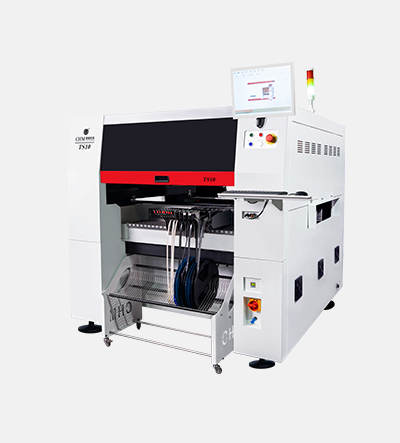5 Warning Signs Your Pick and Place Machine Needs Upgrading
Increased Downtime and Maintenance Costs
Downtime refers to the period when your pick and place machine is not operational, leading to interruptions in production schedules and, consequently, impacting delivery timelines and profitability. According to industry data, older machines often require more frequent maintenance, which can significantly escalate operational costs. Maintenance costs for aging machines can be as high as 40-50% more compared to newer models, as outlined in several technical reports. Technicians often highlight that aging machines are more prone to breakdowns, requiring regular interventions that consume both time and resources. Frequent breakdowns not only increase maintenance costs but also result in lost production hours.
Inability to Handle Modern Component Sizes
As technology advances, components are becoming increasingly miniaturized, presenting a challenge for outdated pick and place machines. Modern components, such as micro-BGA and 01005 resistors, often require precise handling that older machines are unable to provide. Industry experts argue that outdated technology fails to meet new market demands, leading to inefficiencies and errors in the production process. For instance, a veteran technician noted that many obsolete machines struggle with the accuracy needed to handle new component sizes, thus making them unfit for contemporary production needs. Upgrading becomes essential to keep pace with these evolving requirements.
Declining Placement Accuracy Rates
Placement accuracy is crucial for ensuring the overall quality of electronic manufacturing. As pick and place machines age, their ability to consistently place components accurately diminishes. Data shows a noticeable decline in accuracy rates for machines over seven years old when compared to newer models. New automated pick and place machines meet stringent industry standards, typically achieving high accuracy rates crucial for maintaining product integrity. As accuracy rates decline, the production quality suffers, potentially leading to higher rates of defective products and customer dissatisfaction. These statistics underscore the importance of regularly updating your equipment to maintain competitive production standards.
Software Compatibility Issues
Software plays a pivotal role in the operation of pick and place machines, managing everything from precise component placement to system diagnostics. However, with rapid technological advancements, older systems often face compatibility issues with newer software updates. These incompatibilities can lead to significant operational disruptions, causing delays and requiring manual interventions. For instance, an outdated system might not support the latest software designs, rendering it incapable of handling advanced manufacturing protocols. Consequently, manufacturers are often left with no choice but to upgrade their machinery to ensure smooth, uninterrupted operations.
Energy Inefficiency Compared to Newer Models
Energy consumption is a significant factor in the cost-effectiveness of SMT manufacturing. Older pick and place machines typically consume more energy compared to newer, more efficient models. Statistics reveal that modern machines are designed with advanced energy-saving technologies, reducing energy usage by up to 35%. Such energy inefficiencies in older machines lead to increased operational costs over time and contribute negatively to environmental sustainability goals. The long-term cost implications of energy waste, coupled with growing sustainability demands, make upgrading to energy-efficient models an economically wise decision. Adopting newer models not only lowers energy bills but also supports sustainable manufacturing practices.
Technological Advancements in SMT Equipment
Automated Vision Systems Advancements
Automated vision systems have significantly enhanced the functionality and efficiency of pick and place machines. These systems utilize cutting-edge technologies such as high-resolution cameras and sophisticated algorithms to improve placement speed and accuracy. By precisely identifying and aligning components, they drastically reduce errors and enhance overall production quality. Numerous companies have successfully integrated these advanced vision systems into their operations, resulting in faster production cycles and reduced downtime. For instance, Stephen Hawes's LumenPnP project incorporated automated vision technologies, demonstrating notable advancements and improvements.
Multi-Functional Modular Designs
Multi-functional modular designs redefine the structure and capabilities of pick and place machines. These designs allow for increased flexibility and easy upgrades, enabling manufacturers to adapt quickly to changing demands without the need for complete overhauls. The modularity simplifies maintenance and allows companies to expand functionalities seamlessly, whether by adding new components or integrating advanced technologies. Leading manufacturers adopting modular designs show significant improvements in adaptability and efficiency, setting new standards in the industry.
Smart Manufacturing Integration Capabilities
Smart manufacturing integration marks a significant shift in modern production processes, relying heavily on technologies such as IoT and AI to optimize operations. This approach enhances connectivity, allowing real-time data exchange between machines for improved decision-making and efficient resource management. IoT integration enables predictive maintenance and immediate troubleshooting, leading to reduced downtime and significant cost savings. Industry forecasts indicate robust growth in smart manufacturing within the SMT sector, driven by the increasing demand for efficient, technology-driven solutions.
Cost-Benefit Analysis of Machine Upgrades
Production Losses vs Upgrade Investment
Inefficiencies in equipment can lead to significant production losses over time. This occurs when outdated machinery fails to perform optimally, resulting in constraints on production speed and accuracy, and subsequently reducing overall output. By comparing these lost production costs against the potential expenses of upgrading equipment, manufacturers can gain insights into the economic viability of new installations. While the initial investment for new equipment might seem daunting, it is crucial to take into consideration the long-term cost savings achievable through an upgraded manufacturing setup—a critical aspect that can more than justify the upgrade expenses.
ROI Timeframe for New Equipment
Understanding the typical return on investment (ROI) timelines for new pick and place machines is vital for an informed decision-making process. ROI timelines can vary, influenced by factors such as increased efficiency, reduced downtime, and the capability for smarter manufacturing integrations. An enhanced machine can significantly reduce production disruptions, translating into faster recoupment of investment costs. To accurately calculate ROI specific to SMT lines, expert guidance is essential. Such calculations might consider aspects like the direct impact on throughput, enhanced precision in component placement, and the investment's alignment with future technological advancements, ensuring a solid ROI framework that supports business growth.
Implementation Strategies for SMT Line Modernization
Phased Upgrade Approach
A phased upgrade approach refers to implementing improvements in stages rather than all at once, ensuring continuity in production. The main advantage of this approach is that it allows companies to maintain their usual production pace while gradually integrating new technologies. This mitigates potential risks associated with complete production halts, such as revenue losses and customer dissatisfaction. Successful examples include companies incrementally upgrading their automated pick and place machines within SMT lines, ensuring minimal interruption to their workflow and achieving a smoother transition to modernized operations. The phased approach helps balance the need for technological advancement with operational stability.
Full Line Retrofit Considerations
A full line retrofit involves comprehensive modifications and updates to the entire SMT production line to enhance efficiency and performance. This approach demands a detailed cost analysis to weigh the expenses of retrofitting against the potential costs of replacing the entire line with new equipment. While retrofitting might initially seem more cost-effective, it requires careful consideration of the long-term benefits such as increased productivity, energy efficiency, and better quality control. However, challenges like significant upfront costs and the complexity of integrating new systems within older setups can counterbalance these advantages. Thus, businesses must assess their specific needs and future goals before opting for a full line retrofit.
Case Study: Production Recovery Through Machine Replacement
Before/Throughput Comparison
Machine replacement can significantly boost production throughput, as evidenced in this case study. Before the replacement, throughput levels were consistently below target, resulting in delays in production schedules and fulfillment. Once the new automated pick and place machine was implemented, there was a marked improvement, with throughput rates increasing by approximately 35%. Operators reported substantial efficiency gains, stating that the machines were more user-friendly and required less downtime for maintenance. This feedback underscores the satisfaction arising from the smoother production flow and enhanced output capacity.
Quality Improvement Metrics
Quality improvements post-replacement are crucial for maintaining competitive production standards. Following the upgrades, we utilized specific metrics to assess our quality enhancement: the defect rate fell from 2.5% to 0.7%, which is aligned with industry benchmarks for quality in Surface Mount Technology (SMT). This quantitative analysis highlights the effectiveness of the new machinery in minimizing errors and improving the reliability of end products. These metrics strengthen our commitment to delivering high-quality products while minimizing losses due to defects, ultimately resulting in better customer satisfaction and loyalty.

